My view of nature in the city is often informed by my own experiences in my part of the world: Los Angeles, California. About 5 years ago I was given a Palo Verde tree which my husband and I planted in a strategic location to provide shade and beauty in the back of our four unit apartment building (each of the owners owns their apartment). In the U.S. such a situation requires a Home Owner’s Association (HOA) to manage the property together, along with a set of adopted rules — Covenants, Conventions, Conditions and Restrictions (CC&Rs). When we moved in with our current co-owners (minus my mother who passed away), we all agreed on a car free backspace. Consequently much money and labor was spent jackhammering out the concrete pad and converting the “garages” to non-car use space: a party/bedroom, my husband’s office, and a tool shop…and creating a garden.
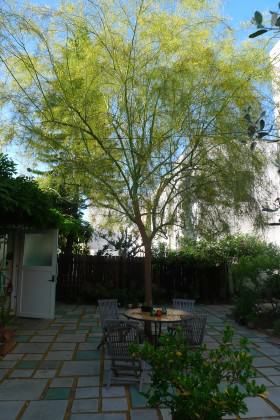 The Palo Verde has been quite a surprise. It shot up rapidly and has created an exceptional umbrella canopy that in the spring is covered with yellow blossoms that attract beautiful black and brown bumble bees, honeybees, wasps and birds. Other times of the year small finches seem to find sustenance on the bark and needle like leaves that I can’t figure out. They make lovely small chirping noises. Unintentionally, we have the daily benefit of looking out onto its canopy from our bedroom on the second floor due to its location; leaving the windows open we hear the birds chirping while foraging.
The Palo Verde has been quite a surprise. It shot up rapidly and has created an exceptional umbrella canopy that in the spring is covered with yellow blossoms that attract beautiful black and brown bumble bees, honeybees, wasps and birds. Other times of the year small finches seem to find sustenance on the bark and needle like leaves that I can’t figure out. They make lovely small chirping noises. Unintentionally, we have the daily benefit of looking out onto its canopy from our bedroom on the second floor due to its location; leaving the windows open we hear the birds chirping while foraging.
But this tree, like plants in our front planting strip, has rather unexpectedly become the center of controversy in our building, provoking a close scrutiny of the HOA CC&Rs — what exactly were the rules we adapted when we each bought our unit from the collective pool of ownership? The CC&Rs had been found on the internet and adopted without too much close reading, and upon scrutiny revealed a series of potential “violations” one member of the HOA is concerned about, as will be explained. The plants in the planting strip were the subjects of a neighbor’s wrath last year.
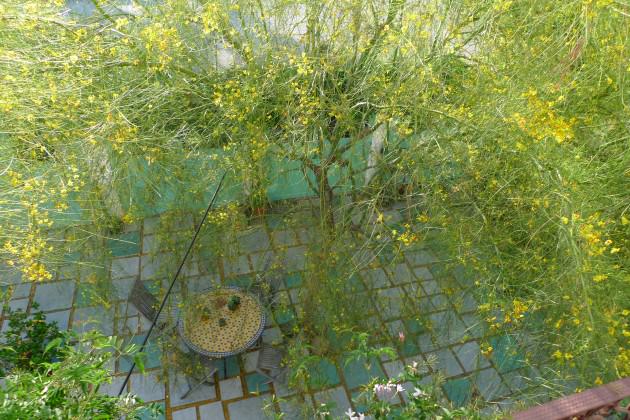 Old habits are hard to change. The Palo Verde makes it difficult to access one of the converted garages if the designated owner of the garage wished to park in it regularly. That building owner — whose garage is now more difficult to access — now would like to park a car in the garage for the six months of the year during which they are absent. Because the tree blocks easy access it has been cast as potentially causing “adverse possession” by that owner. Fellow building owners have offered to switch garages or to pay for off site garaging. The car can be parked, but it requires skill and maneuvering to do so. Moreover, the driveway is now lined by small boulders and is a gardening space, the back area is covered with pavers that are not well embedded in the soil, so moving a car across these areas is not easy and would damage the people centric and oriented new infrastructure. The owner who would like to park the car has suggested either moving the Palo Verde (now 30 feet tall), or planting another at the edge of the property and when it has grown, cutting this one down. Or failing compromise (that is, the acceptance of one of these options), cutting the tree down by fiat.
Old habits are hard to change. The Palo Verde makes it difficult to access one of the converted garages if the designated owner of the garage wished to park in it regularly. That building owner — whose garage is now more difficult to access — now would like to park a car in the garage for the six months of the year during which they are absent. Because the tree blocks easy access it has been cast as potentially causing “adverse possession” by that owner. Fellow building owners have offered to switch garages or to pay for off site garaging. The car can be parked, but it requires skill and maneuvering to do so. Moreover, the driveway is now lined by small boulders and is a gardening space, the back area is covered with pavers that are not well embedded in the soil, so moving a car across these areas is not easy and would damage the people centric and oriented new infrastructure. The owner who would like to park the car has suggested either moving the Palo Verde (now 30 feet tall), or planting another at the edge of the property and when it has grown, cutting this one down. Or failing compromise (that is, the acceptance of one of these options), cutting the tree down by fiat.
These issues have also had repercussions on who “gets” to park in the remaining driveway. As the commercial strip on next street expands and becomes more successful, adjacent street parking is at a premium, and at times residents must park a block away. Such inconvenience has added insult to injury, and then generated parking claims on the driveway as well. To date, there has been little contention over my husband and I parking in the driveway.
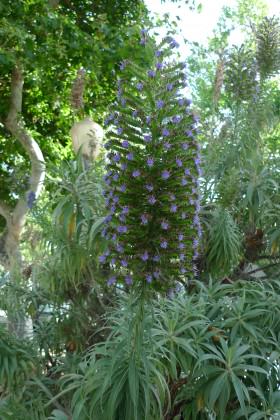 Similar reactivity to nature replacing car space is found in the note from the neighbor about our plants in the front planting strip. The 8 foot tall Echium attracts pollinators, like the Palo Verde; its blue flowers are the admiration of others of our neighbors. And in a drought-prone region, our planting strip vegetation needs little water while the Palo Verde seems to have found plenty of water by itself. But the Echium makes getting in and out of a parked car more difficult, and is seen to obstruct general access.
Similar reactivity to nature replacing car space is found in the note from the neighbor about our plants in the front planting strip. The 8 foot tall Echium attracts pollinators, like the Palo Verde; its blue flowers are the admiration of others of our neighbors. And in a drought-prone region, our planting strip vegetation needs little water while the Palo Verde seems to have found plenty of water by itself. But the Echium makes getting in and out of a parked car more difficult, and is seen to obstruct general access.
These trivial, but ubiquitous examples illustrate the degree to which a car-oriented infrastructure remains dominant in people’s deep priorities. Despite good intentions, and verbal agreements (as in our case), it seems that those get swept away when it comes to one’s own car needs. I suggest that underneath the car-priority arguments is really the way in which property rights and values are co-dependent with the car, as I will discuss below.
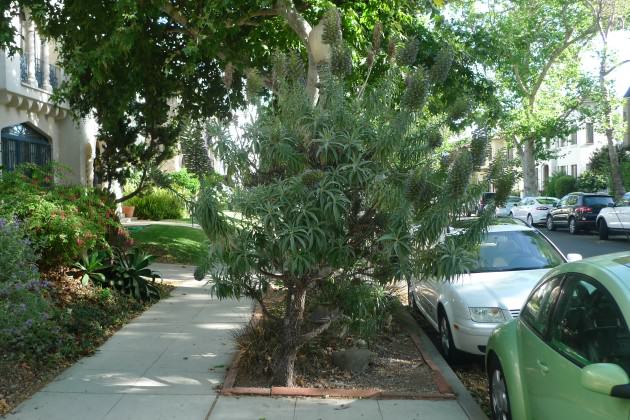 These incidents make me aware of profound difficulties in changing neighborhoods to less car dependency and the car rights mentalities, as well as instituting plant pallates that are out of the ordinary. Our neighbor was clearly advocating we recreate the planting strip lawn to be more in harmony with the rest of the street. Our building neighbor is more divided about things. Acknowledging the beauty of the tree and the pleasantness of the back area, the owner is attempting to finesse a situation that probably cannot be. We can have the tree and plants, or remake a car infrastructure, but not both. This is hard to admit.
These incidents make me aware of profound difficulties in changing neighborhoods to less car dependency and the car rights mentalities, as well as instituting plant pallates that are out of the ordinary. Our neighbor was clearly advocating we recreate the planting strip lawn to be more in harmony with the rest of the street. Our building neighbor is more divided about things. Acknowledging the beauty of the tree and the pleasantness of the back area, the owner is attempting to finesse a situation that probably cannot be. We can have the tree and plants, or remake a car infrastructure, but not both. This is hard to admit.
Turning to the HOA, it prohibits drying clothes outside. The beneficence of solar radiation in the case of our building, must be captured by our solar collectors, sent through the grid, and then sent back to us through the meter to run the clothes dryer, if the HOA “rules” were enforced. Either that, or I dry clothes on racks in my apartment. Here again, nature in the city, in the form of direct solar energy, is not appreciated and taken advantage of in a commonsense manner.
Codification of energy use can be found in many subtle and hidden nooks and crannies of daily life, from HOAs to notions of the value of property and “property rights,” and implicit assumptions about how convenient automobile access — and car use — should be. At the same time, California’s laws — SB 375 and AB 32 — are desperately attempting to reduce GHG emissions by reducing vehicle miles travel and car dependency. And there are many calls for climate appropriate landscaping, pollinator refuges and biodiversity friendly habitats in cities due to the drought, and disappearance of pollinators and local biodiversity.
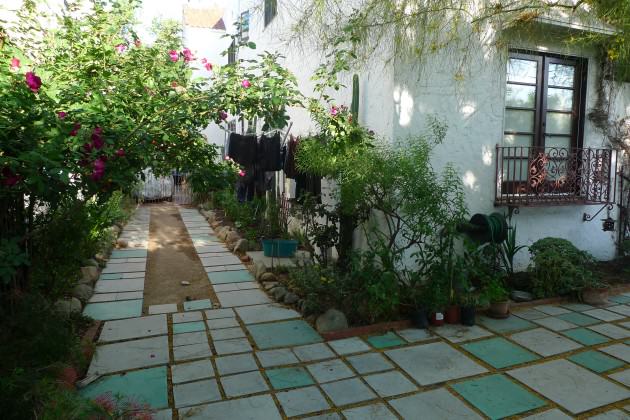 While my examples may seem petty, they are emblematic of the attitudinal issues, reinforced by 20th century codes and conventions and infrastructure, that make current cities hard to change. We have coevolved hard and soft infrastructures that reinforce one another to harden pathways that then reinforce each other. Soft infrastructures include the rules — street widths, sidewalk widths, planting regulations, parking provisions and regulations. Hard infrastructures are the product of those soft infrastructures, but then reinforce them because they become normalized and an architecture of dependence gets erected upon them. These include the conflation of car access with property values. The challenges of the 21st century will include unraveling the knot of this reinforcing interaction between hard and soft infrastructures in our urban areas. To make friendly spaces for nature, the most obvious open space is that devoted to cars. Car infrastructure — parking lots, parking garages, parking garages, parking spaces, streets — create multiple negative externalities. These include polluted run off, lack of permeable filtration areas, heat islands, unwalkable urban spaces, not to mention facilitating cars that produce air pollution and GHGs; the list is long. To reduce energy use in urban areas, we must also begin to use readily available nature’s services like direct sunlight to dry clothes!
While my examples may seem petty, they are emblematic of the attitudinal issues, reinforced by 20th century codes and conventions and infrastructure, that make current cities hard to change. We have coevolved hard and soft infrastructures that reinforce one another to harden pathways that then reinforce each other. Soft infrastructures include the rules — street widths, sidewalk widths, planting regulations, parking provisions and regulations. Hard infrastructures are the product of those soft infrastructures, but then reinforce them because they become normalized and an architecture of dependence gets erected upon them. These include the conflation of car access with property values. The challenges of the 21st century will include unraveling the knot of this reinforcing interaction between hard and soft infrastructures in our urban areas. To make friendly spaces for nature, the most obvious open space is that devoted to cars. Car infrastructure — parking lots, parking garages, parking garages, parking spaces, streets — create multiple negative externalities. These include polluted run off, lack of permeable filtration areas, heat islands, unwalkable urban spaces, not to mention facilitating cars that produce air pollution and GHGs; the list is long. To reduce energy use in urban areas, we must also begin to use readily available nature’s services like direct sunlight to dry clothes!
I do not believe the hostility to the Palo Verde, hanging clothes outside, or to our planting strips is out of ill will or ill intention per se. It emanates from a historically informed and culturally passed on sense of order and priority. It also is a reaction against something different that does not fall into the existing codes, norms and conventions. What if our building co-owner wanted to sell? Would the prospective buyer be put off by not being able to easily park his or her car? Would they be offended by the sight of drying clothes (actually the clothes line is in the driveway, and not visible from the back yard). Would the prospective buyer see the planting strip as unattractive, hence not willing to pay “full market value” for the unit? These are unknowable, and there might even be the exact opposite effect — a heightened value for the unit.
Creative solutions like using a commercial parking garage for overnight parking has not caught on in this part of the world, though in places like Paris, they are a normal matter of course since the city was built pre-automobile. Walking a couple of blocks with packages, children or pets, is simple part of the course of a normal day in pre-auto cities. Concentrating the car in common parking structures, reducing parking requirements and enhancing yet more transit opportunities and bicycling, would free up the car-devoted space in back areas for plants, gardens and human leisure, and facilitate the creation of complete streets.
But in the city of the car — Los Angeles — the culture shift is difficult. Los Angeles was built during a time of abundance of land, energy, water, building materials. We were profligate, though now, perhaps counter intuitively, L.A. is (depending on the source), either the first or second most dense metropolitan area of the United States. Our transit ridership is right behind Chicago. Our transit system is huge, growing and heavily used. Bike lanes are being built and there are more bike riders. People are planting edible plants in parking strips and fighting their cities (there are 88 in Los Angeles County) as well as their neighbors. Change is happening, but it is a slow, step-by-step, person-by-person, building-by-building effort.
Seems like there should be a better way; do we really have time for this process?
Here are a few suggestions that are suitable to Los Angeles:
— Create “alternative” HOA CC&R boilerplates accessible on the internet and fully vetted by the legal community that explicitly encourage drying clothes outside and disallow cars in common areas, encourage gardening including landscaping planting strips. Such restrictions are common, and are preventing people from behaviors more appropriate to a changing climate
— Dramatically reduce city parking requirements.
— Require commercial parking garages to offer neighborhood parking from 6 pm – 10 am.
— For the Southwest region in general, forbid planting of lawns and require installation of indoor and outdoor water meters.
— Legalize garage conversions.
— Work with the nursery industry to phase out water loving outdoor plants.
— Create city policy to encourage planting pollinators and to create habitat refuges.
Rules, codes, conventions and habits emerge from particular times. In the U.S., as people had more appliances and energy was inexpensive, people bought washing machines and clothes driers (this was also a result of clever and instant marketing by appliance makers, and energy utilities to grow their markets). Gradually the perception grew that hanging clothes outside was unsightly. (I recently spoke to a colleague who told me that in new housing developments in Jakarta, outside clothes drying is now banned). And these ideas became codified in Covenants, Codes and Restrictions (CC&Rs) of housing developments, similarly to the requirement for lawns. These have been widely discussed over the past several decades, but no alternatives seem to have emerged.
CC&Rs, a soft infrastructure of rules, create hard infrastructures on the ground: more natural gas lines, or electricity provision to dry clothes; more need for water infrastructure to keep lawns green and more fuel to maintain those lawns with mowers, blowers and edgers. City rules require garages for cars, and increase the amount of urban space devoted to the automobile rather than to other uses, like plants and trees. There are no provisions for sharing existing parking rather than building new, individual parking for each building. The alternatives exist, but the fear of the reduction of property values that people perceive as protected by these rules, makes change difficult. Unless all property owners are subject to the same rule changes, individuals will find change risky and will resist it. But new rules would create a level playing field, and new habits would form. A new normal would develop.
We can do this, we just need the framework to facilitate the change.
Stephanie Pincetl
Los Angeles


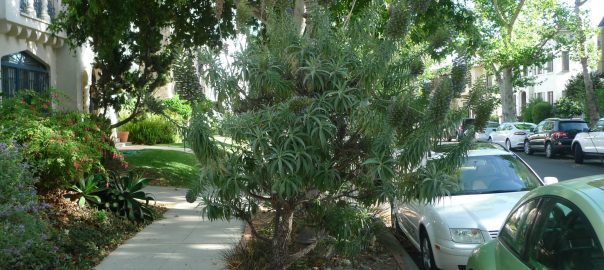
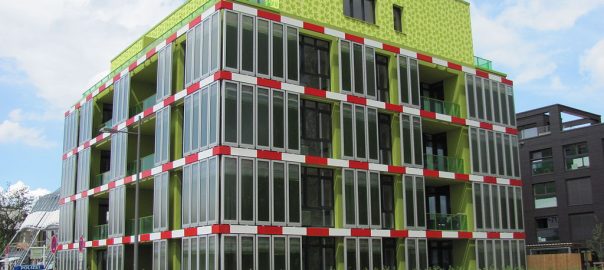
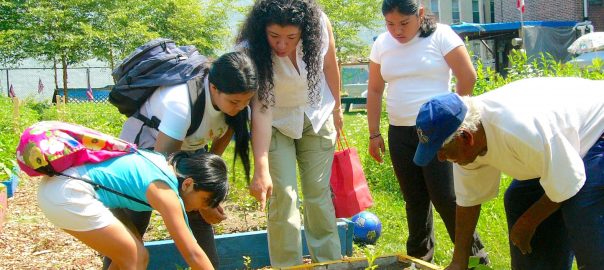
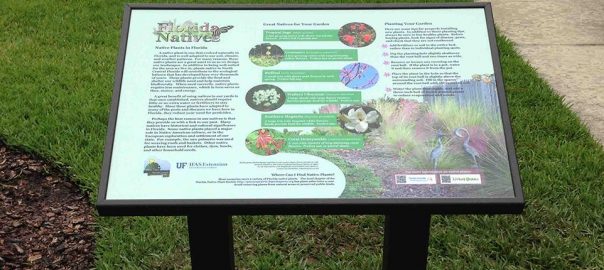
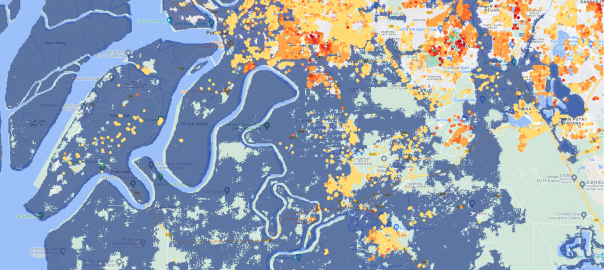
Leave a Reply